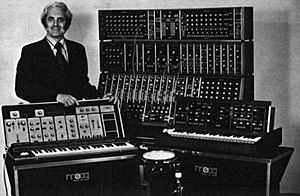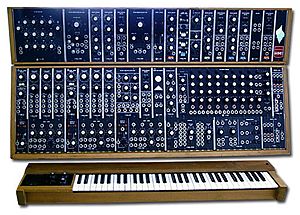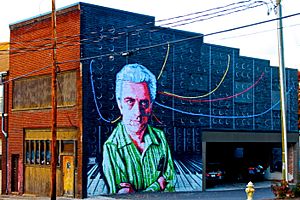Robert Moog facts for kids
Quick facts for kids
Robert Moog
|
|
|---|---|
 |
|
| Born |
Robert Arthur Moog
May 23, 1934 New York City, New York, U.S.
|
| Died | August 21, 2005 (aged 71) |
| Alma mater | Bronx High School of Science Queens College Columbia University Cornell University |
| Occupation | Electronic music pioneer, engineer, inventor of Moog synthesizer |
| Spouse(s) | Shirleigh Moog (m. 1958, div. 1994; three daughters, one son) Ileana Grams (m. 1996, his death 2005) |
| Relatives | Florence Moog (aunt) Bill Moog (cousin, founder of Moog Inc.) |
Robert Moog (born May 23, 1934, died August 21, 2005) was an American engineer. He was a pioneer in electronic music. He created the first widely available synthesizer, called the Moog synthesizer, in 1964. Later, in 1970, he made the Minimoog. This smaller, more portable synthesizer became very famous and important.
Moog received a Technical Grammy Award in 2002. He was also added to the National Inventors Hall of Fame. His life and work are explored in the book Switched On: Bob Moog and the Synthesizer Revolution.
By 1963, Moog was already designing and selling theremins. These are electronic instruments played by moving your hands in the air. He was also studying for his PhD in engineering physics. He developed his synthesizer because musicians wanted easier and cheaper electronic music tools. Moog listened to their ideas and requests.
A key invention by Moog was the voltage-controlled oscillator. This allowed the pitch of a sound to be changed using voltage. He also introduced important ideas like modular design. This means the synthesizer was made of separate parts. He also developed envelope generation (how sounds start and fade) and the pitch wheel. He helped bring synthesizers to many people. This greatly influenced the development of popular music.
Moog loved his work as a hobby. He was more interested in inventing than in making money. He only patented one of his designs, a special filter. Many people think he could have become very rich if he had patented his other ideas. But because his inventions were available to everyone, the synthesizer industry grew much faster.
In 1971, Moog sold his company, Moog Music. He continued to work there as a designer until 1977. In 1978, he started a new company called Big Briar. In 2002, he bought back the rights to the Moog Music name and changed Big Briar's name back. In his later years, Moog taught at the University of North Carolina at Asheville. He also kept working on new instrument designs. He passed away at 71 from a brain tumor.
Contents
Early Life and Education
Robert Moog was born in New York City on May 23, 1934. He grew up in the Flushing area of Queens. He finished high school at the Bronx High School of Science in 1952.
As a child, Moog's parents wanted him to learn piano. But he preferred spending time in his father's workshop. His father was an engineer. Robert became very interested in the theremin. This is an electronic instrument where you control sound by moving your hands near antennae. When he was 14, in 1949, he built his own theremin. He used instructions he found in a magazine.
Moog earned a degree in physics from Queens College. He also got a degree in electrical engineering from Columbia University in 1957. He later earned his PhD in engineering physics from Cornell University in 1965.
Robert Moog's Career
Building Theremins
In 1953, Moog created his own theremin design. The next year, he wrote an article about the theremin for a magazine. In the same year, he started his first company, RA Moog. He sold theremins and kits to build them by mail order from his home. He did this while he was still studying. One of his customers was Raymond Scott. Scott changed Moog's theremin to be played with a keyboard. He called it the Clavivox.
Creating the Moog Synthesizer
While at Cornell, Moog started working on his first synthesizer parts with composer Herb Deutsch. At that time, synthesizers were huge machines that filled entire rooms. Moog wanted to build a smaller, more affordable synthesizer. He hoped it would be useful for musicians. He believed that being practical and affordable were the most important things.
In 1964, Moog began building the Moog synthesizer. It was made of separate modules. These modules created and shaped sounds. They were connected using patch cords. Older synthesizers used hundreds of vacuum tubes to make sound. Moog used newer transistors instead. These transistors allowed him to control sound with voltage.
With these transistors, he invented the voltage-controlled oscillator (VCO). This part created a sound wave whose pitch could be changed by adjusting the voltage. He also used voltage to control how loud a sound was with voltage-controlled amplifiers (VCAs). Another new feature was its envelope. This controlled how notes would swell and fade. Moog's ideas for these modules helped create the modern analog synthesizer.
Moog showed his new instrument for the first time in 1964. It was much smaller than other synthesizers. It was also much cheaper, costing about $10,000. Other synthesizers cost hundreds of thousands of dollars. Older synthesizers were programmed with punchcards. But Moog's synthesizer could be played with a keyboard. This made it very appealing to musicians. It was described as the first commercial synthesizer.
Moog saw himself as a "toolmaker." He designed things for people to use, not just for himself. His ideas came from requests and suggestions from musicians. These included Herb Deutsch, Richard Teitelbaum, Vladimir Ussachevsky, and Wendy Carlos. Many universities also set up electronic music labs with Moog synthesizers. In 1970, Moog released the Minimoog. This was a smaller, portable version. It became one of the most famous and important synthesizers ever.
Company Challenges
Even though Moog was a brilliant engineer, he was not a strong businessman. He focused on inventing as a hobby. He admitted he didn't know much about business. He compared the experience to riding a roller coaster. You know you won't get badly hurt, but you're not fully in control.
Moog only patented his filter design. Many people believe he could have become very rich if he had patented other ideas. For example, his pitch wheel design. If Moog had kept control over his ideas like modularity and voltage control, the synthesizer industry might not have grown as it did.
In 1971, Moog Music took on investors. It then merged with another company, Norlin Musical Instruments. The company moved to a new location during a difficult economic time. Moog stayed on as a designer until 1977. He said he would have left earlier, but his contract required him to stay for four years to get his stock. By the end of the 1970s, Moog Music faced competition. Other companies were making cheaper and easier-to-use instruments.
New Beginnings and Legacy
In 1978, Moog moved to North Carolina. He started a new company called Big Briar. He also worked as a consultant for another music company from 1984 to 1988. In the early 1990s, he taught music at the University of North Carolina at Asheville. In 2002, he bought back the rights to the Moog Music name. He then renamed Big Briar to Moog Music. In his later years, he continued to design electronic instruments. This included a piano controlled by a touchscreen.
Moog's inventions have had a lasting impact on music. The BBC called him a pioneer of synthesized sound. His inventions changed both pop and classical music. His name became so well-known that people sometimes used "Moog" to mean any synthesizer. In 2004, a documentary film called Moog was made about him.
Moog received many awards. These included honorary doctorates from several universities. He also received a Grammy Trustees Award in 1970 for his lifetime achievements. In 2001, he received the Polar Music Prize. In 2002, he got a special Technical Grammy Award. In 2012, Google celebrated Moog's birthday. They created an interactive Minimoog as their Google Doodle on their homepage. In 2013, Moog was added to the National Inventors Hall of Fame.
Moogseum
In August 2019, the Bob Moog Foundation opened the Moogseum. This museum is in Asheville, North Carolina. It is dedicated to Moog's work. The museum displays rare theremins, early synthesizer parts, and Moog's original documents.
Images for kids
See also
 In Spanish: Robert Moog para niños
In Spanish: Robert Moog para niños








